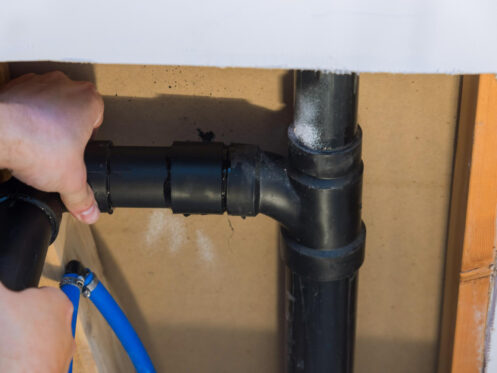A leaky pipe can turn from a small drip into a major problem that damages your home and increases your water bill. Most homeowners face this issue at some point, but the good news is leaky pipes repair can be done quickly without replacing the entire pipe.
Acting fast when you spot a leak can prevent extensive water damage and save you money on repairs.The key is knowing how to identify the warning signs early and understanding which temporary fixes can buy you time before a professional arrives.
In this article, we’ll walk you through everything you need to know about pipe leak repairs, from spotting problems early to understanding repaircosts and preventing future leaks.
Below, we’ll walk through each important aspect:
- Spotting the signs of a leaking pipe early
- Temporary fixes you can try before calling a plumber
- What to expect during professional leaky pipe repair
- Leaky pipe repair costs and what affects the price
- Preventing future pipe leaks in your home
Keep reading whether you’re dealing with a small drip or a more serious leak, you’ll learn practical solutions that can help protect your home.
Spotting the signs of a leaking pipe early
Finding water leaks before they cause major damage can save thousands in repaircosts. Hidden leaks often show subtle signs like damp spots, strange odors, or changes in water pressure that many homeowners miss.
The EPAestimates that the average household loses around 9,400 gallons of water annuallydue to hidden leaks like pinhole breaks, running toilets, or slow drips .
Common household symptoms of hidden water leaks
Water stainson walls or ceilings often appear as yellow or brown spots. These marks show where water has been dripping or pooling over time.
Musty odorsin certain rooms can signal hidden leaks. When water sits in dark spaces, it creates perfect conditions for mold and mildew growth.
We should watch for these warning signs:
- Unexplained increases in water bills
- Sounds of running water when no taps are on
- Damp or soft spots on floors
- Peeling paint or wallpaper
- Low water pressure throughout the house
Foundation crackscan develop when underground pipes leak. The extra moisture weakens the soil around your home’s base.
Warm spotson floors often mean hot water pipes are leaking underneath. Walk barefoot across your floors to check for temperature changes.
Why slab leaking is harder to detect and more dangerous
Slab leaking happens when pipes under your concrete foundation crack or break. These hidden leaks are tough to spot because they occur beneath thick concrete slabs.
Hot spots on floorsare the most common sign of slab leaking. The leaked water warms the concrete above, creating areas that feel warmer than the rest of the floor.
We might notice these symptoms:
- Cracks in walls or floors
- Doors and windows that stick
- Wet carpets with no clear source
- Sound of running water under floors
Foundation movementoccurs when slab leaking continues over time. The extra water changes soil conditions and can cause your house to shift or settle unevenly.
Expensive repairsmake slab leaking especially dangerous. Fixing these problems often requires breaking through concrete and can cost thousands of dollars.
How to tell if your faucet is leaking behind the scenes
According to the EPA, even a faucet dripping one drop per second can waste over 3,000 gallons per year—enough water for 180 showers—so fixing loose washers promptly is crucial.
Faucet leaks don’t always happen at the spout where we can see them. Many leaks occur behind walls or under sinks where they can cause serious damage.
Water stainsunder kitchen or bathroom sinks indicate leaking supply lines. Check the cabinet floors and walls for dark spots or warped wood.
Loose faucet handlesoften mean internal parts are worn out. When seals fail, water can leak into the wall behind the fixture.
We should look for these signs:
- Water pooling in sink cabinets
- Mineral deposits around faucet bases
- Handles that turn too easily
- Reduced water flow from the spout
Corrosionaround faucet connections shows where water has been leaking slowly. Look for white or green buildup on metal parts under sinks.
Temporary fixes you can try before calling a plumber
You can stop most pipe leaks temporarily using basic tools and materials from your local hardware store. These quick fixes help prevent water damage while you wait for professional repairs.
Sealing a Leaking Pipe Without Replacing It
Pipe repair clampswork best for most leaks. These metal bands have rubber gaskets that wrap around the damaged area. They fit both metal and PVC pipes.
Clean the pipe surface first. Remove any dirt or rust around the leak. Place the rubber gasket over the hole. Wrap the metal clamp around it and tighten with a screwdriver.
Pipe wrap tapecreates a waterproof seal for smaller leaks. We recommend self-adhesive types over regular duct tape. Start wrapping about 2 inches before the leak. Overlap each layer by half the tape width.
Pull the tape tight as you wrap. Continue past the leak for another 2 inches. This creates a strong seal that can last several weeks.
Epoxy puttyworks well for pinhole leaks. Knead the putty until it becomes one color. Press it firmly into the hole and surrounding area. Let it cure for the time listed on the package.
Safe DIY options for slowing a water leak
Turn off the water supply before starting any repairs. Find the shut-off valve closest to the leak. This prevents more water from flowing out.
Rubber patcheswith hose clamps slow larger leaks safely. Cut a piece of rubber from an old inner tube or buy a patch kit. Place it over the leak and secure with two hose clamps.
Pipe sleevesslip over the damaged section. These plastic or rubber tubes have adhesive inside. Cut them to fit over the leak area. They compress around the pipe when installed.
For joint leaks, we can tighten the connections carefully. Use two wrenches to avoid twisting the pipes. Turn the fitting clockwise slowly until the leak stops.
When temporary repairs can actually cause more harm
Over-tighteningpipe fittings can crack the pipe or strip the threads. This creates bigger leaks that cost more to fix. Stop turning when the leak stops.
Using wrong materialson high-pressure lines is dangerous. Duct tape and electrical tape only work on low-pressure drain pipes. They will fail on water supply lines.
Ignoring the main problemleads to bigger issues. Temporary fixes buy you time but pipes still need proper repair. Old repairs can fail suddenly and cause flooding.
Mixing different metalscreates corrosion problems. Steel clamps on copper pipes can cause faster deterioration. Use clamps made for your specific pipe type.
Call a plumber within a few days of making temporary repairs. Even good temporary fixes will eventually fail and cause water damage.
What to expect during professional leaky pipe repair
Professional plumbersuse specific tools and methods to find and fix different types of leaks. The repair process varies depending on whether you have slab leaks, wall leaks, or faucet problems.
How plumbers diagnose leaking pipes with precision
Professional plumbers start with a visual inspection of your plumbing system. They check water pressure levels and look for obvious signs of damage.
Electronic leak detectionhelps locate hidden leaks behind walls or under slabs. These devices can pinpoint exact leak locations without unnecessary digging or wall removal.
Plumbers use acoustic equipmentto listen for water sounds inside pipes. This method works well for finding leaks in pressurized water lines.
Thermal imaging camerasdetect temperature changes that indicate water leaks. Cold spots often show where water escapes from hot water pipes.
The diagnosis process takes 30 minutes to 2 hours depending on leak complexity. Plumbers will explain their findings and show you the problem areas before starting repairs.
The repair process for slab leaking and wall leaks
Slab leakingrequires accessing pipes beneath your concrete foundation. Plumbers may need to break through flooring or use tunneling methods under the house.
Professional repair involves:
- Shutting off main water supply
- Creating access points through slab or walls
- Removing damaged pipe sections
- Installing new pipes or fittings
- Pressure testing the repairs
Wall leaksneed careful drywall removal to reach the pipes. We preserve as much wall material as possible during access.
Plumbers use pipe reliningfor minor cracks in slab pipes. This method inserts a new liner inside existing pipes without major excavation.
Slab leak repairs take 1-3 days depending on pipe location and damage extent. Wall leak fixes usually complete within 4-8 hours.
What makes leaking faucet repair different from pipe leaks
Faucet repairsfocus on internal components rather than pipe replacement. Most faucet leaks come from worn washers, O-rings, or cartridge problems.
Professional faucet repair includes:
- Disassembling the faucet handle and stem
- Inspecting internal seals and moving parts
- Replacing worn components
- Reassembling and testing water flow
Pipe leaksrequire cutting and joining new pipe sections. Faucet work involves smaller parts and precise adjustments.
Faucet repairs take 30 minutes to 2 hours and cost much less than pipe replacement. We can often fix faucet problems without shutting off your main water supply.
Some faucet types need complete replacement if internal damage is extensive. Professional plumbers carry common faucet parts and can complete most repairs in one visit.
Leaky pipe repair costs and what affects the price
Pipe repair costs range from $150 for simple fixes to over $5,000 for complex repairs inside walls. The final price depends on pipe material, leak location, and how severe the damage is.
Average cost to fix different types of leaks
Simple exposed pipe repairscost between $150 and $500. These are leaks we can easily reach and fix quickly.
Pipe leaks inside wallscost much more. We typically see prices from $500 to $5,000 or higher for these repairs.
Underground pipe leaksare among the most expensive. Main water line repairs average $1,025 but can range from $354 to $1,697. Water line breaks can cost up to $1,575.
| Leak Type | Cost Range |
| Exposed pipes | $150 – $500 |
| Pipes in walls | $500 – $5,000+ |
| Underground pipes | $354 – $1,697 |
Ceiling leakscost more than wall repairs. This is because we need special equipment to access pipes above your head safely.
Materials, location, and severity: what changes your bill
Pipe materialsmake a big difference in repair costs. PVC pipes are cheaper to fix than copper pipes. Galvanized steel pipes often need more expensive repairs.
Location matters mostfor your final bill. Pipes hidden behind walls or under concrete slabs take longer to reach. We need to cut through materials and repair them afterward.
Severity affects labor timeand materials needed. Small pinhole leaks need simple patches. Burst pipes require full section replacements and cleanup work.
Additional costsinclude diagnostic fees to find hidden leaks. We might discover bigger problems once we start working. Hardware and fittings add to material costs.
Why acting fast can actually save you money
Water damage costsgrow quickly when we ignore leaks. A small drip can cause thousands in damage to floors, walls, and belongings.
Structural damagehappens when water soaks into wood and drywall. We see rot, mold, and foundation problems that cost much more than the original pipe repair.
Higher water billsadd up over time. Even small leaks waste hundreds of gallons monthly. This increases your utility costs significantly.
Emergency repairscost more than planned fixes. Weekend and holiday service calls include extra fees. We recommend fixing leaks during regular business hours when possible.
Prevention saves moneyin the long run. Regular maintenance helps us catch small problems before they become expensive emergencies.
Preventing future pipe leaks in your home
We can stop most pipe leaks before they start by building good habits, upgrading old plumbing, and managing water pressure and temperature properly. These steps protect our homes from water damage and save money on repairs.
Smart habits that reduce the risk of water leaks
Regular pipe inspections help us catch problems early. We should check exposed pipes under sinks and in basements monthly for signs of wear or small drips.
Key areas to inspect:
- Pipe joints and connections
- Areas aroundwater heaters
- Basement and crawl space pipes
- Kitchen and bathroom plumbing
We need to avoid putting grease down drains. This blockspipes and creates pressure that causes leaks. Instead, we should dispose of cooking oil in the trash.
Gentle use of fixturesprevents damage. We should turn faucets and valves slowly rather than forcing them. Quick, hard movements stress pipe connections.
Daily habits that help:
- Turn off water when brushing teeth
- Fix dripping faucets quickly
- Don’t hang items on exposed pipes
- Report leaks to landlords immediately
Upgrading plumbing to avoid frequent repairs
Old pipes need replacement to prevent constant leaks. We should replace pipes older than 20 years, especially galvanized steel ones that rust easily.
Modern materials last longer and resist corrosion. Copper and PVC pipes handle daily use better than older materials. We can upgrade problem areas first if full replacement costs too much.
Upgrade priorities:
- Main water lines
- Bathroom supply lines
- Kitchen plumbing
- Basement pipes
Professional installation ensures proper connections. We should hire licensed plumbers for major upgrades. They know building codes and use quality materials.
Signs we need upgrades:
- Frequent repairs in the same area
- Rusty or discolored water
- Low water pressure throughout the house
- Pipes that make loud noises
The role of water pressure and temperature in pipe damage
High water pressure damages pipes over time. We should keep pressure between 40-60 PSI to prevent stress on joints and connections. A pressure gauge helps us monitor this.
We can install pressure regulators if our water pressure runs too high. These devices protect our entire plumbing system and reduce wear on appliances.
Temperature control prevents damage:
- Set water heater to 120°F maximum
- Insulate pipes in cold areas
- Let faucets drip during freezing weather
- Shut off water when leaving for winter trips
Insulation protects pipes from extreme temperatures. We should wrap pipes in unheated areas like garages and crawl spaces. This prevents freezing and the expansion that cracks pipes.
Sudden temperature changes stress pipe materials. We should avoid running very hot water immediately after cold water. This thermal shock can weaken connections and cause leaks.
Conclusion
We’ve covered several effective methods to fix leaky pipes without replacing them. Most repairs can be done with basic tools and materials.
We recommend starting with temporary fixes when you discover a leak. This prevents water damage while you gather materials for permanent repairs.
Most small leaks can be fixed in under 30 minutes. Keep repair materials on hand for quick fixes.
The methods we discussed work for different pipe materials. Metal pipes, PVC, and copper all respond well to these techniques.
Acting fast prevents costly water damage. Even small drips waste water and increase utility bills.
We’ve shown you that pipe repair doesn’t have to be complicated. With the right approach, you can handle most leaks yourself and save money on plumber visits.
Contact Splash Plumbing for fast, professional leaky pipe repair anywhere in Orange County—before minor drips turn into major damage.












